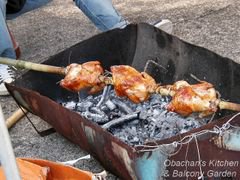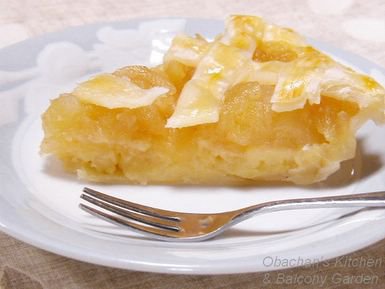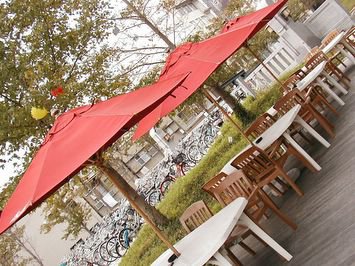 OK, my busiest time of the month is finally over and now I have time to write about the Japanese sauces I have in my kitchen, as requested by one of dear readers about two weeks ago. I don’t know if this is going to be helpful for anyone, but some people might, at least, find this interesting. Honestly I learned a lot from doing this, and I really thank Sara for bringing up this idea. OK, my busiest time of the month is finally over and now I have time to write about the Japanese sauces I have in my kitchen, as requested by one of dear readers about two weeks ago. I don’t know if this is going to be helpful for anyone, but some people might, at least, find this interesting. Honestly I learned a lot from doing this, and I really thank Sara for bringing up this idea.
In this post, the ones with photos are the ones I actually have in my kitchen now. I also wrote about some popular variations, and tried to include some trivia that even Japanese people may not have heard of. Of course I’m no expert, so corrections and feedbacks from readers are highly appreciated! :) And I hope you enjoy this as much as I did.
* For each entry, in front of the explanations, I put 1) possible product name in English, 2) its Japanese name spelled with the alphabet, 3) with Chinese characters, and 4) with hiragana (Japanese syllabary).
* Information included in this post may not apply to the similar products sold outside Japan.
Read More
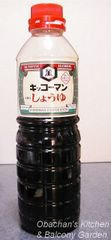 Dark soy sauce, koikuchi shoyu 濃口醤油 こいくちしょうゆ: (See photo.) Real basic and versatile liquid seasoning made from soybeans. When a Japanese recipe calls for “soy sauce (shoyu, 醤油 しょうゆ),” it usually means this type of soy sauce, unless the recipe specifically mentions other types of shoyu. Dark soy sauce, koikuchi shoyu 濃口醤油 こいくちしょうゆ: (See photo.) Real basic and versatile liquid seasoning made from soybeans. When a Japanese recipe calls for “soy sauce (shoyu, 醤油 しょうゆ),” it usually means this type of soy sauce, unless the recipe specifically mentions other types of shoyu.
Light soy sauce, usukuchi shoyu 薄口醤油 うすくちしょうゆ: Used for simmered/steamed dishes that shouldn’t be colored too brown with the sauce. Though the color is lighter, its salt-content is higher than dark soy sauce. To make the saltiness milder, amazake (non-alcoholic? drink made from fermented rice) is added. More commonly used in Kansai area than in Kanto. They say the difference can be observed by comparing the color of noodle soup; Kanto-style noodle soup is much darker than Kansai-style soup.
Tamari soy sauce, tamari shoyu 溜醤油 たまりしょうゆ: Very dark, thick soy sauce used as dipping sauce for sashimi and sushi.
White soy sauce, shiro shoyu 白醤油 しろしょうゆ: Amber colored sauce mainly made from wheat. Contains more sugar than soy sauces made from soybeans. Not sterilized by heating, thus contains live yeast and expires faster than other kinds of soy sauces. Used for simmered/steamed dishes that shouldn’t be colored brown with the sauce.
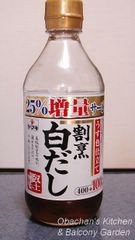 Concentrated dashi seasoning, shiradashi/shirodashi 白だし しらだし/しろだし: White soy sauce or light soy sauce blended with various kinds of dashi stock. The stock is mainly made from dried bonito flakes, kelp and dried black mushrooms. Can be used as the substitute for light soy sauce. (That's why I don't buy light soy sauce any more and buy this instead.) Concentrated dashi seasoning, shiradashi/shirodashi 白だし しらだし/しろだし: White soy sauce or light soy sauce blended with various kinds of dashi stock. The stock is mainly made from dried bonito flakes, kelp and dried black mushrooms. Can be used as the substitute for light soy sauce. (That's why I don't buy light soy sauce any more and buy this instead.)
 Dashi powder, hunmatsu dashi, 粉末だし ふんまつだし: I was really tempted to call this Hondashi ほんだし, but it’s a product name by a particular brand, like calling a photocopy machine “Xerox,” so I used a name that sounds more "generic" above. Anyway, I've found many miso-soup recipes written in English telling you to make dashi stock from dried bonito flakes and/or kelp. That’s a traditional, formal way, and probably the best way, but do you really think that we do that every morning?! Especially those busy housewives who have to cook breakfast and pack lunch for husbands and kids, and then go out for a part-time work? No way. Dashi powder, hunmatsu dashi, 粉末だし ふんまつだし: I was really tempted to call this Hondashi ほんだし, but it’s a product name by a particular brand, like calling a photocopy machine “Xerox,” so I used a name that sounds more "generic" above. Anyway, I've found many miso-soup recipes written in English telling you to make dashi stock from dried bonito flakes and/or kelp. That’s a traditional, formal way, and probably the best way, but do you really think that we do that every morning?! Especially those busy housewives who have to cook breakfast and pack lunch for husbands and kids, and then go out for a part-time work? No way.
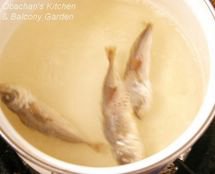 Using bonito flakes for making dashi is not only time consuming but an expensive luxury! Can you imagine how much you have to use for one time… and how much garbage that’ll make? So proudly, we --- at least my family members and relatives --- depend on this type of dashi powder for everyday meals, and I’m sure a lot of Japanese families are like us. (When I want some extra dashi flavor for my miso-soup, I throw in some dried baby fish in addition to dashi powder and take them out before adding other ingredients to the soup.) Using bonito flakes for making dashi is not only time consuming but an expensive luxury! Can you imagine how much you have to use for one time… and how much garbage that’ll make? So proudly, we --- at least my family members and relatives --- depend on this type of dashi powder for everyday meals, and I’m sure a lot of Japanese families are like us. (When I want some extra dashi flavor for my miso-soup, I throw in some dried baby fish in addition to dashi powder and take them out before adding other ingredients to the soup.)
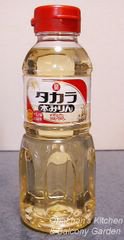 Rice Wine, mirin 味醂 みりん: Made from glutinous rice, malted rice and shochu (distilled spirit). Contains apx. 13 – 14% alcohol (thus, alcohol tax applied in Japan) and apx. 40% sugar and its color is similar to vinegar. Widely used for things like simmered food, teriyaki, soups, dressings, sweets, etc. Essential for giving sweetness and glossy sheen to teriyaki-type of dish. Various amino-acids and succinic acid contained add extra flavor, and the alcohol helps the food absorb the flavor of seasonings. When the taste of alcohol is not desired, should be boiled briefly beforehand to let alcohol evaporate. Often called hon-mirin (本味醂 ほんみりん) to distinguish from mirin-like seasoning mentioned below. Rice Wine, mirin 味醂 みりん: Made from glutinous rice, malted rice and shochu (distilled spirit). Contains apx. 13 – 14% alcohol (thus, alcohol tax applied in Japan) and apx. 40% sugar and its color is similar to vinegar. Widely used for things like simmered food, teriyaki, soups, dressings, sweets, etc. Essential for giving sweetness and glossy sheen to teriyaki-type of dish. Various amino-acids and succinic acid contained add extra flavor, and the alcohol helps the food absorb the flavor of seasonings. When the taste of alcohol is not desired, should be boiled briefly beforehand to let alcohol evaporate. Often called hon-mirin (本味醂 ほんみりん) to distinguish from mirin-like seasoning mentioned below.
Mirin-like liquid seasoning, mirin-huu chomiryo みりん風調味料 みりんふう ちょうみりょう: Made by adding glutamic acid and other seasonings to thinned syrup (glucose sugar or starch syrup). Its alcohol content is less than 1%, and sugar content is higher than mirin. Not necessary to boil before using.
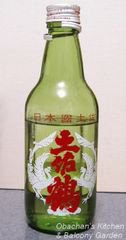 Sake, sake 酒 さけ: Now this is something I do but many Japanese housewives may not: I use drinking sake for cooking, not cooking sake (ryori-yo sake 料理用酒). It doesn’t have to be this brand in the photo, but it HAS TO be drinking sake. For me it makes a BIG difference in taste. Sake, sake 酒 さけ: Now this is something I do but many Japanese housewives may not: I use drinking sake for cooking, not cooking sake (ryori-yo sake 料理用酒). It doesn’t have to be this brand in the photo, but it HAS TO be drinking sake. For me it makes a BIG difference in taste.
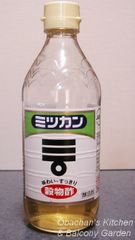 Vinegar, su 酢 す: Usually refers to the kind of vinegar made from several kinds of grains such as wheat, rice and corn. More precisely, this type is classified as grain vinegar, kokumotsu su 穀物酢 こくもつす. Most regular and inexpensive kind. Vinegar, su 酢 す: Usually refers to the kind of vinegar made from several kinds of grains such as wheat, rice and corn. More precisely, this type is classified as grain vinegar, kokumotsu su 穀物酢 こくもつす. Most regular and inexpensive kind.
Rice vinegar, komezu 米酢 こめず: Vinegar made from rice. A little milder and deeper flavor of this vinegar is said to be most suitable for Japanese traditional vinegared dishes, but this is a little more expensive than grain vinegar.
Sushi vinegar, sushizu すし酢 すしず: Grain vinegar with sugar, salt and dashi-seasonings added. Basic ingredients necessary for seasoning sushi rice are already included, so you can make sushi rice by mixing this vinegar alone to warm rice (but I prefer mixing sushi vinegar my own way).
Ponzu sauce, Ponzu ぽん酢 ぽんず: A sauce made by mixing ingredients including citrus juice, mirin, dashi-stock, soy sauce, and vinegar. The name came from a Dutch word, “pons” which means citrus (juice).
 Yuzu-mixed Ponzu, yuzu-pon ゆずぽん: Ponzu with extra yuzu flavor. I have to have this when I eat nabe (Japanese hotpot dish). Yuzu-mixed Ponzu, yuzu-pon ゆずぽん: Ponzu with extra yuzu flavor. I have to have this when I eat nabe (Japanese hotpot dish).
Worcestershire sauce, usuta- sosu, ウスターソース: If you eat at a casual eatery in Japan and see a small container on the table with a label saying simply “ソース(sauce),” it’s almost always Worcestershire sauce.
 Tonkatsu sauce, tonkatsu sosu, とんかつソース: Thicker and sweeter sauce made by adding a lot more fruits/vegetables than Worcestershire sauce. Good with cutlets, okonomi-yaki お好み焼き (Japanese savory pancakes) and takoyaki た こ焼き (octopus balls). There are sauces specifically named “okonomi-yaki sauce” お好み焼きソース and "takoyaki sauce" たこ焼きソース, too, but they are basically not too different from tonkatsu sauce, I think …just some difference in flavor, sweetness and/or thickness. Tonkatsu sauce, tonkatsu sosu, とんかつソース: Thicker and sweeter sauce made by adding a lot more fruits/vegetables than Worcestershire sauce. Good with cutlets, okonomi-yaki お好み焼き (Japanese savory pancakes) and takoyaki た こ焼き (octopus balls). There are sauces specifically named “okonomi-yaki sauce” お好み焼きソース and "takoyaki sauce" たこ焼きソース, too, but they are basically not too different from tonkatsu sauce, I think …just some difference in flavor, sweetness and/or thickness.
-----
Well, this should be enough for part I. While working on this write-up, I thought, “Oh, maybe I can write about sugar, miso, flour and cooking oil, too!!” So there probably will be part II someday in the near future, unless you find this type of entry distasteful and tell me not to post any more ;)
Categories: Seasonings
|
![]()
![]()
![]()
![]()
![]()
![]()
![]()
![]()
![]()
![]()
![]()
![]()



















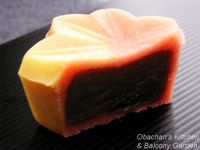






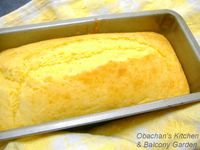





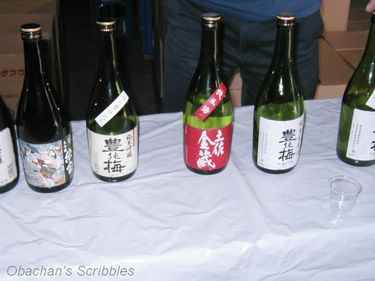


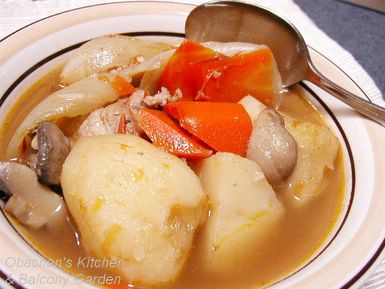









 Using bonito flakes for making dashi is not only time consuming but an expensive luxury! Can you imagine how much you have to use for one time… and how much garbage that’ll make? So proudly, we --- at least my family members and relatives --- depend on this type of dashi powder for everyday meals, and I’m sure a lot of Japanese families are like us. (When I want some extra dashi flavor for my miso-soup, I throw in some dried baby fish in addition to dashi powder and take them out before adding other ingredients to the soup.)
Using bonito flakes for making dashi is not only time consuming but an expensive luxury! Can you imagine how much you have to use for one time… and how much garbage that’ll make? So proudly, we --- at least my family members and relatives --- depend on this type of dashi powder for everyday meals, and I’m sure a lot of Japanese families are like us. (When I want some extra dashi flavor for my miso-soup, I throw in some dried baby fish in addition to dashi powder and take them out before adding other ingredients to the soup.)






